 Where did you go to school? Oregon State University for undergraduate, University of Colorado (Denver, CO) for PT school.
Where did you go to school? Oregon State University for undergraduate, University of Colorado (Denver, CO) for PT school.
What is your hometown? Corvallis, OR
Tell us about your family! I was born and raised here in Corvallis and am lucky enough to still have most of my family here. I am also very excited be getting married this summer and be able to go on an amazing honeymoon to Europe! We also have two cats that keep us on our toes.
What are your hobbies or favorite activities? I love to run, hike, and play soccer whenever I get the chance. I also really enjoy reading and am trying to take up quilting!
Why did you choose Physical Therapy? Why do you like working at Corvallis Sport and Spine? I am fascinated by the way the human body works and I love being able to use my knowledge to help people learn to move without pain and get back to whatever their “sport” is! I love CSSPT because of the positive energy. Anyone who walks in the door is instantly met with a smile!
What are your favorite types of patients to treat or areas of interest? I love working with high school athletes, runners, and people who just had surgery as well as anyone who is interested in getting rid of pain and moving a little bit better.
What is your favorite exercise? I love band walks! Challenging your hip stabilizers and core is important for everyone, especially runners!
What’s in your purse right now? A book, snacks, headphones, wallet
What’s playing on your ipod for a great workout? Spotify playlists created by my fiancé – anything from Taylor Swift to Modest Mouse can get me pumped up!
What’s your guilty pleasure TV show? Friends – thank you Netflix!
Shoulder and back pain after mastectomy – a reality!
A mastectomy can affect your shoulders, neck, and upper back years down the road –Physical Therapy can help avoid both the general pain and disabling shoulder pain afterwards.
Physical Therapy is an important component and is often missed in the treatment of breast cancer patients. Studies have shown, even years after a mastectomy, individuals can develop compensatory movement and posture of the shoulder blade muscles. This can lead to shoulder pain, or in more extreme cases, adhesive capsulitis (frozen shoulder). Patients can also develop irreversible nerve damage, which can cause discomfort to the cervical spine or neck. These symptoms of pain, immobility, and strength deficits can reduce quality of life long after the cancer treatments have ended.
Mastectomy pain is often the result of scarring and adhesion formation that occurs to help the body heal after radiation or surgery. Adhesions that persist after a mastectomy can cause disabling pain and dysfunction in the neck and upper back.
Women who have healed their superficial scars can have pain at the surgical scar, throughout the chest wall, and into the shoulders or arms without symptoms of significant lymphedema being present. Mild to severe symptoms of tightness can occur, often feeling like a straightjacket across the chest wall. This could affect the manner in which someone breathes, further affecting posture and abdominal muscle recruitment patterns (core strength).
Common complications that physical therapy can address:
- Scar tissue and adhesions to avoid stiff joints movement and postural restrictions.
- Swelling – surgical treatment or radiation can disrupt lymphatic circulation and cause a buildup of protein rich fluid resulting in lymphedema. This may cause heaviness and fatigue or tingling sensations in the limb and can be addressed by a therapist trained in lymphedema treatment called manual lymph drainage.
- Nerve symptoms – scar tissue and postural guarding with muscle spasm can cause impinge upon nerves resulting in significant pain. Physical Therapy can relieve symptoms related to this
- Muscle weakness/deconditioning – post cancer treatment muscle weakness can cause postural changes that can affect the shoulder area. A Physical Therapist will evaluate and treat this.
- Radiation fibrosis – causes deep scarring which creates decreased movement and tightness of the joints. This can affect posture in the long term and can also compromise lymphatic circulation.
Physical therapy treatment can assist in reducing the myofascial adhesions, restoring nerve mobility and restoring normal breathing and movement patterns. These improvements lead breast cancer survivors back to live, work, and play again.
Carrol Esterhuizen, PT, MHS, OCS, CPI, DPT, Doctor of Physical Therapy
How to modify exercises in mid-life – what is important to include
We’re all getting older and unfortunately aging does come with some challenges. These include decreased bone density and lean (muscle) mass along with an increase in body fat and a higher risk for cardiovascular disease. Some of these changes are intensified in women after menopause. Many people are also exercising or being active less often resulting in declines in balance, coordination, and strength. While that doesn’t sound very encouraging, fortunately there is something you can do to mitigate these negative side effects of aging!
Exercise (including cardiovascular training, strengthening, and flexibility) can make serious positive changes in all of the areas listed above!
Most exercise recommendations talk about the intensity with which you are exercising. This can sometimes be confusing so let’s make it simple! There are two main ways to gauge the intensity of your exercise – as a percentage of your maximum heart rate (HR max) and the rating of perceived exertion (RPE).
RPE: This is the easiest to determine. No calculation required, it’s purely based on how hard you determine you’re working. This should be in the somewhat hard to hard range as seen. Below this is too easy, but working into the very hard range can lead to injury and may deter you from exercise!
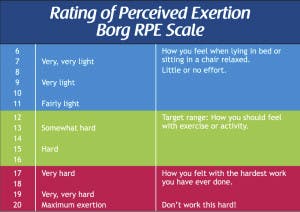
Courtesy of: https://www.zentofitness.com/treadmill-tabata-workout-9-rate-of-perceived-exertion-rpe/
HR max: This calculation determines your maximum heart rate. You can use this to then determine your exercise intensity as a percentage of this maximum heart rate. The higher the percentage, the higher the intensity. Moderate intensity is usually between 50-60% of your HR max. This range matches pretty well with your interpretation of somewhat hard above, but it does depend on each persons interpretation of how hard they’re working! You can use a heart rate monitor or take your pulse to figure out your heart rate!
HR max = 220 – (your age)
Example: 55 year old HR max = 220 – 55 = 165 beats per minute (bpm)
Moderate exercise intensity: 165 x 50% = 82.5bpm
Exercise recommendations from the American College of Sports Medicine (ACSM):
Aerobic (cardiovascular endurance): 2-3 days per week for >30 min at a moderate intensity (RPE of 11-13, 50-60% HR max)
Examples: walking, jogging, swimming, dancing
Strengthening (resistance training): 2-3 days per week; choose 8-10 exercises and perform 1-3 sets of 10-15 repetitions (the last 1-2 should be hard to perform)
Examples: body weight exercises, resistance bands, circuit training, free weights, weight machines
Flexibility (stretching): >2 days per week performing 8-10 stretches for 10 minutes. Light intensity (very slight discomfort), hold each stretch for 30+ seconds and repeat up to 3 times
Examples: major muscle groups – calf, quadricep, hamstring, shoulders
Those are the keys to modifying your exercise as you age to maintain a healthy life. Remember, you can’t change your chronological age, but you can change your physiological (you’re body’s make up) age!
Happy Exercising!
– Erin Bell, PT, DPT, Doctor of Physical Therapy
Resources:
https://www.nia.nih.gov/health/publication/exercise-physical-activity/introduction
https://well.blogs.nytimes.com/2015/04/15/the-right-dose-of-exercise-for-a-longer-life/?smid=fb-nytimes&smtyp=cur&bicmp=AD&bicmlukp=WT.mc_id&bicmst=1409232722000&bicmet=1419773522000&_r=2
https://www.sciencedirect.com/science/article/pii/S2095254614000386
Incontinence – It's normal, but should it be?
Short answer – No!
Now for the long answer. One quarter of women in the US have some sort of pelvic disorder including urinary incontinence. Most think it is something that is normal after having children or just part of the aging process but this simply isn’t the truth. Physical therapy and pelvic floor strengthening has been shown to be an effective treatment for both men and women dealing with urinary incontinence.
There are different types of incontinence and your treatment may vary depending on which type is most similar to your symptoms. Determining the difference between stress or urge incontinence is the first step in determining the appropriate treatment.
Urge incontinence occurs when the bladder spasms, causing you to leak urine in large or small amounts. This can happen frequently. There may or may not be muscle weakness in the pelvic floor.
Stress incontinence occurs when there is increased pressure on the bladder (sneezing, laughing, coughing, lifting) and is often due to weakness in the muscles of the pelvic floor. This weakness can be due to childbirth, surgery or trauma, and lack of exercise. People with stress incontinence are prime candidates for physical therapy! Your physical therapist will help you strengthen your pelvic floor muscles as well as help you learn how to lift or move with good body mechanics.
Functional incontinence means that there is another primary condition that is affecting bladder control – including joint pain, confusion or dementia, environmental factors (bathroom is too far away), or psychological issues (including depression).
You can also have a combination of different types of incontinence. Your physician or physical therapist will be able to help you determine which category you fit in best and what the most appropriate treatment will be.
If you are experiencing urinary incontinence, keep a bladder diary to help you see the patterns that emerge. You could also try avoiding common bladder irritants (click here for a full list) and check in with your physical therapist for help in exercising and lifting correctly. If this is a new condition, be sure to talk with your physician about your symptoms to make sure there isn’t a more serious cause for your incontinence.
-Erin Bell PT, DPT,Doctor of Physical Therapy
References:
https://www.apta.org/Media/Releases/Consumer/2008/9/17/
https://www.moveforwardpt.com/SymptomsConditionsDetail.aspx?cid=a357f7d4-02f1-49cc-b03c-299c69d6dfc6#.VRxaB0Iinq0
https://www.acog.org/-/media/For-Patients/faq081.pdf?dmc=1&ts=20150401T1650590659
Bone Density Post Menopause
Attention women! If you’re not thinking about your bones – you should be! After menopause, bone density decreases, leaving you with a higher risk for a fracture of your hip (femur) or even your vertebrae. We’re targeting women today because of the 10 million Americans with osteoporosis, 80% are women. There are multiple factors that speed up bone loss in women including the decrease of estrogen (a hormone that normally protects bone density) after menopause and the fact that most women have smaller bones to begin with.
There are two main factors that play into your chances of becoming osteoporotic – how much bone density you had to start out with and how fast you lose bone mass after menopause (varies from person to person).
There isn’t much you can do to change how fast you lose bone mass, but you can do a lot to change your bone density leading up to menopause. Make sure you eat a balanced diet, exercise (including impact activities), and avoiding smoking or drinking will set you up for the best bone health possible. Your bone density peaks at about age 30 so start now!
If you are already past 30 or even past menopause, don’t worry – we have some bone health tips for you!
- Exercise! Physical therapists are often sharing the benefits of exercise but one that doesn’t get talked about enough is the positive effect it has on maintaining bone density. It is important to make sure you are doing some weight bearing (standing) exercises – that good stress that comes with impact is what helps tell your bones to stay strong.
- Load up on calcium! Dairy products, fish, and green leafy veggies are great choices.
- Talk to your doctor! Some people need supplements for calcium, vitamin D, or even medications designed to increase your bone health or estrogen levels. Your doctor can give you more information if these are appropriate options for you.
- Moderation! Caffeine, alcohol, and salt don’t have to be “never” foods in your diet, but try to make them “sometimes” foods. They all affect your body’s ability to maintain a healthy bone density level.
If you’re concerned about your risk for osteoporosis or low bone density, talk to you doctor. If you are over 65, you should be screened by your physician. If you are younger than 30, be proactive and build up as much bone mass as you can! Your physical therapist can help you answer questions about appropriate exercises for whatever stage of life or bone density you may be at!
-Erin Bell PT, DPT, Doctor of Physical Therapy
References:
https://nof.org/articles/235
https://www.everydayhealth.com/news/how-to-boost-bone-health-menopause/
https://www.womenshealth.gov/publications/our-publications/fact-sheet/osteoporosis.html
5 Tips to Prevent Injuries in Tennis Athletes
Tennis players experience a mix of chronic (overuse) injuries and acute injuries. The most common injuries include tennis elbow (lateral epicondylalgia), shoulder injuries, stress fractures, and sprains or strains. Most of these injuries can be prevented with appropriate strengthening, stretching, and warm up activities! If you are starting to have any kind of pain in your shoulder, elbow, or any other part of your body while you play, make sure you get in to see your physical therapist as soon as possible! To prevent pain, check out these suggestions:
1. Pay attention to your racquet!
- The weight, length, grip size, and string tension of your racquet will affect your swing and ability to control the ball. Make sure to get your racquet fitted to you to prevent any extra strain at your wrist and elbow.
- Check out this website for racquet tips: https://www.tennisexpress.com/images/How-to-choose-the-right-racquet.gif
2. Get in a good warm up!
- A dynamic warm up is critical before any high intensity athletic event. You need to make sure your muscles and nervous system are ready for the explosive movements that you will be doing! We have a great example of a dynamic warm up on our YouTube page!
https://www.youtube.com/watch?v=6yciHFiIQx4
3. Strengthen your wrists and forearms!
- There is a reason tennis elbow got its name – strain on the elbow and wrist extensor muscles can be painful. Having poor form with your swing or an incorrectly sized racquet can cause symptoms. Using an elastic band to strengthen these muscles can help. Sit in a chair with a band under your foot with the other end in your hand. Flex your wrist up, keeping the rest of your arm still. Turn your hand the opposite direction and repeat. Try 2 sets of 20 repetitions!
4. Focus on your shoulder!
- A lot of your power for your swing comes from the shoulder and all the muscles around the shoulder blade. You should be keeping these muscles strong and the shoulder stable, especially when swinging at high speeds. Practice keeping your shoulder blades squeezed down and back (like you were putting them in your back pockets!) to prevent shoulder pain.
5. Don’t forget the lower body!
- Your power comes from your core and your hip muscles. Making sure to include lower body strengthening like lunges or squats along with core strengthening exercises (planks, bridges) is critical for both injury prevention and improving your game!
Tennis requires the whole body to be strong, from your racquet hand to your feet! You should be participating in a stretching routine after your workouts and a strengthening routine 2-3 days each week to keep your body in prime condition and avoid those injuries!
Game, set, match!
- Erin Bell PT, DPT
References:
https://www.tennisexpress.com/images/How-to-choose-the-right-racquet.gif
https://www.stopsportsinjuries.org/tennis-injury-prevention.aspx
5 Tips for Injury Prevention for Track and Field Athletes
As you are gearing up for the start of track season, it is important to consider how you are going to keep yourself healthy from day one to your final meet. 50% of all youth track and field athletes experience some type of injury – make sure you aren’t one of them! The most common type of injury is an overuse injury, which is usually preventable! The following tips are aimed at helping you avoid injury and perform at your best this season.
1. Preseason Conditioning
- This is one of the most beneficial things an athlete can do before the season even starts. Making sure you have built up a solid base of both cardiovascular endurance and strength is critical to avoiding the common pains often seen in the first few weeks of training. Ask your coach for workouts that you can perform on your own or with a few teammates! You can also schedule a visit with a Physical Therapist to screen your movement and identify some areas you can improve and prescribe specific exercises to improve your movement health!
2. Proper Stretching: Dynamic before, Static after
- One of the easiest things to do to prevent many muscle strain injuries is to consistently perform a dynamic warm up before your practice/workout and a stretching routine afterwards.
- Dynamic warm up – It is important to get your body warmed up before engaging in strenuous activity. Light jogging, skipping, and dynamic stretching (lunges, high knees, butt kickers, etc) should be performed at the beginning of every workout! Check out our YouTube page for a few videos to get you started!https://www.youtube.com/watch?v=oyy2NAwY-vE&list=PLMPotZhzzZ7ghQo-QQ_YEhKjwbFTk20sO&spfreload=10
- Stretching – You need to stretch the major muscle groups (quadriceps, hamstrings, calves, hip flexors, shoulders/chest) after you workout. Avoid bouncing at the end of your stretch and make sure you hold your stretches for at least 30 seconds!
3. Proper Strengthening
- Make sure you are incorporating some strengthening exercises into your training routine. For runners, jumpers, and throwers hip and core strength is absolutely critical to both injury prevention and successful performance of your event. The bulk of this strengthening should happen during your offseason. This doesn’t have to include weights or machines – body weight exercises or using exercise bands works well!
- If you have pain – make sure you see your physical therapist for a full assessment of your pain and for instruction in the best exercises for you.
4. Check your shoes!
- If they have more than 500 miles on them, it might be time for a new pair, especially if you are noticing some knee pain or shin splints. Make sure you have your running stride assessed to get the right type of shoes.
- Check out this older post on choosing the right shoes! https://csspt.com/2014/08/07/5-reasons-you-may-need-new-athletic-shoes/
5. Beware of overtraining
- Last but not least, your training schedule should include both light workouts and rest days. You shouldn’t be running hard more than 5 times a week (including races). Overtraining can actually cause more harm than good, leading to overuse injuries and pain!
You shouldn’t have any pain with your running or throwing events – if you do, make sure you take care of yourself! If a few days of rest and ice don’t take care of it, call us for a full evaluation so we can get you back to full speed sooner!
-Erin Bell PT, DPT, Doctor of Physical Therapy
References:
https://www.cookchildrens.org/SiteCollectionDocuments/Orthopedics/CCPN-Rehab-Track.pdf
"Text Neck"
If you have a cell phone or ever use one, pay attention! Our changing culture of constant texting and browsing on mobile devices may actually be causing you pain  or headaches. Take a look at this picture – what do you look like when you’re on the phone?
or headaches. Take a look at this picture – what do you look like when you’re on the phone?
The next time you’re engrossed in reading an article (or Facebook) take a break and think about your posture. If you’re looking like the person in the far right of the picture – you’re putting 60 pounds of stress on your neck! The average smartphone user spends almost 1,500 hours each year in this position (often closer to 7,000 hours for teenagers). This can lead to chronic neck pain, headaches, and early degeneration possibly leading to chronic pain!
Our smart phones or tablets are here to stay so here are some quick tips to reduce the strain on your neck.
- Take a break! Make sure you are changing positions and stretching your neck frequently.
- Check your posture! Try not to slump or slouch in your chair – sit up tall and try using a smalltowel roll to support your low back.
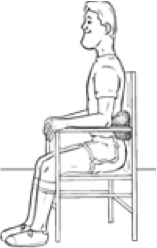
- Try the chin tuck! Sitting or standing with good posture, gently tuck your chin back into your neck (don’t look down!) and hold for 5 seconds. Repeat 10 times and frequently throughout the day!
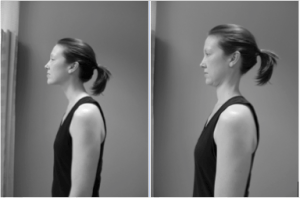
If your neck is hurting and you think your posture or use of technology might be part of the problem, give us a call. We can give you individualized postural instruction, training, and help address any musculoskeletal issues that may be contributing to your pain!
-Erin Bell PT, DPT
Photos Courtesy of:
https://www.washingtonpost.com/news/morning-mix/wp/2014/11/20/text-neck-is-becoming-an-epidemic-and-could-wreck-your-spine/
https://www.youngsurvivorsbhm.org/tip-sheet/stretches-exercises/
https://my.clevelandclinic.org/health/diseases_conditions/hic_your_back_and_neck/hic_How_to_Cope_When_You_Have_Low_Back_Pain
Resolutions 8-10 – Part 4 – Your First and Only Choice for Physical Therapy
Our final resolutions! This week, we’re building off our previous goals with our last three resolutions for our next 10 years! The theme of our last three resolutions is growing ourselves to be your first and only choice for Physical Therapy and movement health and wellness.
8. We will nurture and grow our team with amazing individuals to continue to create a positive and welcoming environment from the front desk to the billing office.
Our staff is committed to making CSSPT a positive and welcoming place from the moment you walk in the front door until you pay your final bill. We want to provide excellent and friendly service as well as the highest quality physical therapy services to help you work, live, and play again!
9. Perform a monthly inservice amongst our therapists to continue to teach each other new skills and refine our current skills to help each other grow to help YOU move better
We strive to keep each other accountable to always refining our skills with continuing education classes. We are constantly learning from each other and want to continue to grow our hands on skills as well as our ability to communicate with you to help you achieve your goals!
10. We want to be your family and your friends’ go-to Physical Therapists!
We are so lucky to live in a state with Direct Access – you can come see us without a referral from your physician! We are the movement experts and are qualified to address your musculoskeletal injuries – and we are also educated to know when to send you back to your physician for imaging or other tests. If you have aches and pains, call us to see if we can help!
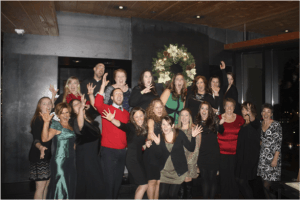
Thanks for letting us share our vision for the future. Our goal is to improve you life by teaching you about your muscles and movement. We want to help teach you to appreciate your body and take care of it! We want to make you play again – life is too short not too! We are so thankful for every patient that comes into our clinic every day because you inspire us and motivate us with your hard work and success!
Happy New Year!
– Corvallis and Albany Sport and Spine Physical Therapy
Resolutions 5-7 – Part 3 – Educating and Supporting our Community
We’re halfway through our resolutions! This week, we’re building off our previous goals with our next three resolutions for our next 10 years! The theme of our next three resolutions is resolving to educate and support our community!
5. Educate our community about how to move better to help prevent injuries before they occur
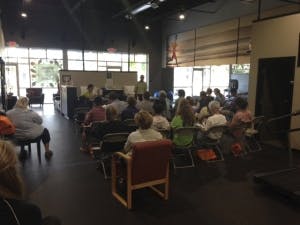
One of our biggest goals with any patient is to not just resolve their current pain or injury, but to prevent future injuries or dysfunction. One huge part of prevention is education – if you know what things you should or should not be doing, you’re able to better avoid those common injury causing events. We love to work with local community groups, big and small, to provide education on fall prevention, aquatic therapy, wellness, and what physical therapists actually do! We also share that kind of information online via our social media pages (like us on Facebook or follow us on Twitter @css_pt or @albanysportspt for more!) and this blog! We want to continue to spread our knowledge to the community over the next 10 years!
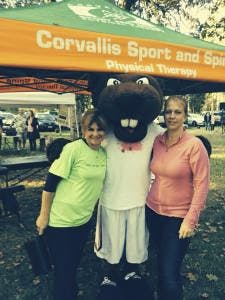
6. Support our community with our presence at service, health, and general community events
Over the years we have been present at farmer’s markets and various 5Ks and recreational athletic events. We have also supported many high school athletic programs via finances and our presence at events and even performing movement screens (see #7). We resolve to be even more resolved. We want to support our community in spirit and in health. We want to be present at events to cast as wide a net as possible of educating our community how to move and live better. If we can do that financially with sponsorships, we want to do that too! We are owned and operated locally all by people who live here – in the Corvallis and Albany area. We want to serve where we live and make it a better place!
7. We will perform two free movement screens each year with a local high school or club sports team.
We love working with the athletes of Corvallis and Albany, especially those that represent our schools and community by playing hard. To keep you on the field, we will provide a thorough screening of the members of a team – free of charge and performed by our Physical Therapists (movement experts!) – to help identify potential risk for injury. Athletes will then receive preventative exercises to help eliminate those risk factors.

– Corvallis and Albany Sport and Spine Team
Last Photo courtesy of:
https://teamchirodm.com/functional-movement-screen/
